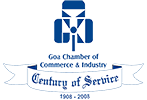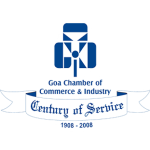

BRIEF HISTORY OF THE CHAMBER
- PRE-LIBERATION
- POST LIBERATION
- LOOKING AHEAD
- CHAMBER PREMISES
Nineteenth-century Goa saw a new class of elite, the result of education available to them. This helped create a bourgeois class that dominated business and interacted with the outside world. Portugal already had its Assogiagao Comercial de Lisboa in 1854. This prompted Goans also to have one.Mr.Luis Guilherme Dias called for a meeting of like-minded businessmen at the house of Dr.Antonio Maria de Cunha, a physician by profession. The meeting took place on 7th July 1907. They decided to form and establish the Assogiagao Comercial da India Portuguesa. On 6th of December 1908, the first Managing Committee was elected and Luis Guilherme Dias became the 1st President of the Chamber. The number of members went on increasing from the 34 founding members. They included a cross-section of different businesses in Goa – from Margao, Sanvordem, Mapuca, Ucassaim, Saligao, Verem etc. There were wholesale dealers, retailers, wood businesses, pharmacy owners, binding enterprises, cloth merchants etc.
Great difficulties were felt by the merchants who imported or exported goods or brought them from the other side of the river Mandovi as there was no jetty which could be used to load and unload the cargo. Transporting the goods by sea was practical and cheaper as road transport was expensive. The new committee requested the government to immediately start the construction of a new jetty near the Dock of Nova Goa for loading and unloading of cargo. It was at the Chamber’s initiative that a banking house was started under the name of Banco da India Portuguesa in 1914. In 1916, the Chamber catalysed the steamship service between Goa and Portugal to boost trade between the two countries. In 1954, when the Government of India imposed an economic blockade against Goa, the Chamber arranged for a Portuguese shipping company to touch Goa directly to minimize hardships to the local population.Another landmark of the Association was the starting of a bulletin ‘Boletim da Assogiagao Comercial da India Portuguesa’ on 15th January 1954. The Assogiagao was also instrumental in keeping the members informed of the overseas traders who wanted to import and export products to and from Goa.
On 19th December 1961, the Indian Government liberated from Portuguese rule. In the new scenario after liberation, the Assogiagao became very active and worked to solve the difficulties faced by the business community and the community in general due to political change. The Chamber took up the various problems confronting the business community with regard to the taxation and made several representations on the subject. Prominent among them was one with regard to the Status of the Hindu Undivided Families in Goa, Notices under Sec.148 of the Income Tax Act, Registration of Firms formed under the Portuguese rule, Exemption of Interest on Loans borrowed from foreigners prior to extension of Income TaxAct of Goa, Daman and Diu.
On 12th April 1962, the members met at the General Assembly and decided that they would change the name from Assogiagao Commercial da India Portuguesa to Goa Chamber of Commerce. In 1968, the Chamber framed the new Bye-laws and changed the name to Goa Chamber of Commerce & Industry. On 19th of April, a delegation of the Chamber had the honour of meeting with the Prime Minister Pandit Jawaharlal Nehru and extended an invitation to him to visit Goa. The Prime Minister came to Goa in May 1963 and during his stay visited the Chamber which hosted a dinner in his honour.
Liberation of Goa also saw the growth of industry in Goa and a change from a mainly agricultural state. It was the need of the hour for the Chamber to orient business and to train its members to become successful entrepreneurs. The Chamber decided to undertake a study to assess the potentialities for the economic development of Goa. It felt that mere expansion of the existing industries would not solve the problems. For successful transformation of the existing trading economy into an industrial one, establishment of a large number of small-scale industries rather than a few large-scale units was required. The Chamber interceded with the Central Government to notify Goa as an industrially backward area so that it would benefit from the various concessions available to industrial units set up in such notified areas.
GCCI has taken up several issues concerning Goan economy with the Government such as infrastructure development, education, employment opportunities, pollution and waste management, which it believes are priorities for the state. Recognising the important role that women play in the society, GCCI established the ‘Women’s Wing’ in the year 2005. The Women’s Wing is active in its various social endeavours. It organises ‘Asturi’ – an annual exhibition to encourage entrepreneurship among women.
The Chamber is actively promoting the State as an ideal destination for IT development and under the aegis of Goa Agenda has held various seminars on subjects like ‘IT for Society’, ‘Emerging Markets in IT’, ‘Outsourcing – Challenges Ahead’, ‘Incubation Centres – Challenges for Replicating Successes’,’ Knowledge as Driver of Goan Economy’, ‘Alternate Delivery Models in IT Industry’ etc. All these seminars were addressed by the leading IT professionals from Indian IT industry.
In September 2011 the Goa Information Technology Innovation Centre – GITIC was set up at GCCI’s state-of-the-art building at Verna, Goa’s premier industrial estate. GITIC, a joint venture between GCCI & the Department of Industries, Govt of Goa, is a business incubator and an investment facilitation centre providing a platform for IT innovators to work on their ideas in high-tech premises with comprehensive business support services. Within a short time of less than a year, it incubated 10 companies thus GITIC played an important role n promoting & entrepreneurship in Goa. After efforts of GCCI along with various bodies such as the Goa Pharma Manufacturers’ Association, Mormugao Port, Customs Commissionerate, Goa was nominated a notified port for pharma exports in Dec’11.
During its 114 years of existence, the Chamber has undergone many changes – in name, function, procedure, style composition and structure. It has however retained the values inculcated by the visionaries who had started this great institution.
On 2nd July 1960, the associação purchased a plot to have its own building and a committee was formed to collect funds for the construction. The industrial magnate Sri Arvind Mafatlal formally inaugurated the building on 10th November 1968 that was built at a cost of Rs.4 lakhs. Mr.Pandurang Timblo was the President of the Chamber at that time.In 2004, under the Presidentship of Mr.Nitin Kunkolienker and in keeping with his corporate philosophy of making the workplace atmosphere a pleasant one, the GCCI Panaji office was redesigned and refurbished to give it a modern, corporate identity. The Surendrababu Timblo Hall was also revamped. It is now a popular venue for events and is much sought after by various associations as well as government bodies.
The Chamber’s building in Panaji was renamed as Narayan Rajaram Bandekar Bhavan on 10th November 2006, due to the generous contribution of Rs. 50 lakhs made by Shri Narayan Bandekar.
The foundation stone of the GCCI building at Verna Industrial Estate was laid on 11th January 2006 at the hands of the Chief Minister Shri Pratapsing Rane in the presence of the Industries Minister Shri Luizinho Faleiro. The state-of-the-art building was inaugurated on 30 May 2008 by Mr.Digambar Kamat, Chief Minister of Goa. Mr. Nitin Kunkolienker was the President of GCCI at the time. Verna premises were sold in the year 2019.
CHAMBER SINCE 1908
- ISSUES THAT WE RESOLVED
- HOW IT ALL STARTED
- OUR ROLE IN TAXATION REFORMS
Ever since its formation, the Chamber had to handle various issues such as export of salt, alteration of exchange rates, construction of the Panjim Jetty, promotion of a banking house, shipping services, representation in the legislative assembly, banking facilities, enhancement of municipal fees, increase in customs tariff, cashewnut exports, export of mangoes and coconuts, restrictions on import of rice, exchange of demonetised Rs. 1000/- notes, exchange cover for Goa’s import from Reserve Bank of India; arbitrary increase in industrial tax, traffic problems, compulsion of use of automatic weighing scales, economic blockade by Government of India and many such issues affecting the interest of business community and consequently affecting Goan economy. Relief measures to those affected by the Sanquelim floods as well as Bengal famine were also undertaken by the Chamber.
The Goan Business Community had to, all of a sudden, face a supply crisis, when the Government of India, in August 1954, imposed an economic blockade against Goa. The Chamber had to take an immediate action in the matter in order that the supply of essential commodities which were, till then, imported from neighbouring markets was maintained through imports. The Chamber also put in strenuous efforts to find suitable alternative markets for export of local commodities like coconuts, areca nuts and salt. A shipping service was arranged to ply between Mormugao and Karachi. When Bombay Dock Workers boycotted steamers carrying goods destined for Goa, the Chamber had to arrange with Portuguese shipping lines to touch Aden from where they could collect goods in transit to Mormugao.
An issue which disturbed the traders was the promulgation by the Portuguese Government around 1959 of the Price Control Order under which margins of profit to be kept by the Traders on various items were fixed. The fixation of margins had no rationality and it was an arbitrary decision prompted by the white rulers. The Chamber had to oppose the order at various levels, since some over enthusiastic Inspectors had started visiting commercial establishments and probing into margins. The main difficulty was the lack of clarity in the order. Till the date of Goa’s liberation, the Chamber had not succeeded in revoking the order. After liberation, though the order was not implemented, it was acting as an eternal sword of Democles hanging over the traders, specially foodgrain dealers. It was finally somewhere in the year 1986 that the Chamber achieved the objective and the order was revoked.
It was in July 1907 that some visionary leaders of Goan business community Messrs. Luis Guilherme Dias, Vincent Salvador Andrade and Bento Minguel Fernandes came together to promote the concept of forming a trade association. On 7th, July 1907 ten distinguished merchants assembled in the house of Mr. Antonio Maria da Cunha to give shape to the proposed, body. At this meeting a committee headed by Mr. Dias was formed to prepare the necessary bye-laws.
The bye-laws were framed and after the necessary discussions were approved at a provisional meeting held on 6th September 1907. They were submitted to the Central Government in Lisbon and formally approved on 3rd September 1908, thus bringing into being a body of Traders under the name and style of Associacao Comercial da India Portuguesa”. Thirty four, founder members met on 6th December 1908 and elected the first Managing Committee under the Presidentship of Mr. Luis Guilherme Dias. The entrance fee for the members was fixed at Rs. 5/- and the annual subscription was fixed at Rs. 6/- . The concept of forming a traders’ body was born as a sequel to the necessity of facing with certain strength, the regulatory mechanisms which were being introduced all over the world in an increasing manner.
Contribuicao Industrial (Industrial Tax) was introduced by Portuguese Government in 1947. Though it was termed “industrial” it was not a tax on industries but a tax on all commercial activities and such other occupations. It was assessed on the basis of what was termed in Portuguese as 10% of “lucro illiquido presumivel” (Presumptive gross income). It was a sort of presumptive tax concept which was introduced in Indian Income Tax Act a couple of years ago. But, in practice, the amount of tax to be paid depended on various types of merchandise handled by the merchant and each type of merchandise was taxed separately. In effect, the business community did not feel the pinch of this tax as the amount to be paid was negligible, though the principle of equity was not adhered to in the system. The amount which was collected through this tax in 1950 was less than Rs. 11 Lakhs. But in 1958, the Director of Fazenda (Revenue Department) proposed the disproportional increase in the rates of this tax and the Chamber started being persuaded from all quarters and vehemently opposed the increase. This was being done as a step towards the forming the overall taxation system and was known as “Reforma Tributari” (taxation reforms). Sensing the mood of the business community, the Chamber arranged to send a delegation to Portugal in August 1958 to plead with the higher Authorities for a sympathetic reconsideration of the issue. The efforts of the Chamber resulted in deferment of the proposal followed by a reduction of 25% in tax rates. Similarly, another important issue emanating from the local import-export Junta signing an accord with England and France in January 1961, on imposition of quota restriction on imports was solved automatically as a result of liberation. The Chamber had pleaded for the review of this accord and for keeping Goa outside the purview of this accord.
GCCI AND ITS DIGNITARIES
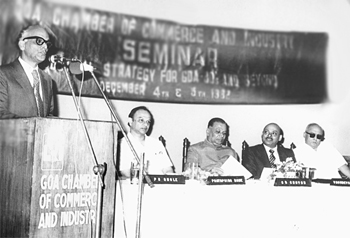
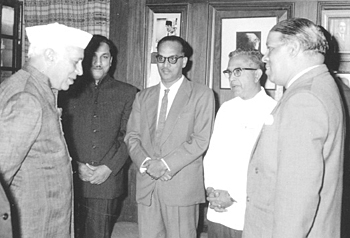
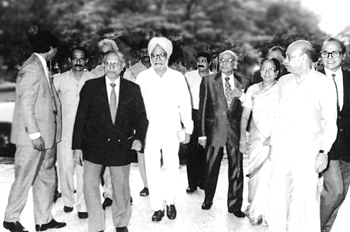
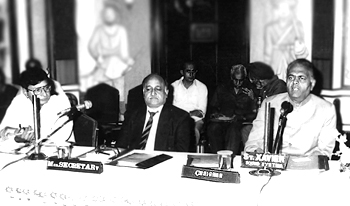
During the years of its existence, the Chamber has had the prestige and the honour of playing host to eminent dignitaries like the Prime Minister Pt. Jawaharlal Nehru, Finance Minister Shri Morarji Desai, Planning Minister Shri S B Chavan. Railway Minster Shri T A Pai and Shri Madhu Dandavate, Finance Minister Shri Manmohan Singh, Minister of State for Finance Shri Shantaram Potdukhe, Governors of Reserve Bank of India, Shri I G Patel, and Shri R N Malhotra, Shri Kureshi of International Finance Corporation, Shri D N Davar, Chairman Industrial Finance Corporation of India. Presidents of Indian Merchants Chamber, Federation of India Chamber of Commerce & Industry, The Associated Chambers of Commerce & Industry of India and eminent Journalist Nani Palkhiwalla, Chairman of IDBI, MSFC, Abid Hussain. Member Planning Commission and a number of other dignitaries such as Ambassadors and Trade Commissioners and Consuls General.
JOIN US
Join GCCI for a rich-resource of free essential business information advice, a busy events calendar and discounted conference facilities.
ABOUT GGCI

Goa Chamber of Commerce & Industry (GCCI) is Goa’s premier non-profit business, support-services and networking organization. We represent and liaise with SME’s, Corporate Organisations and Government bodies.
CONTACT US
GOA CHAMBER OF COMMERCE & INDUSTRY
Narayan Rajaram Bandekar Bhavan, T.B. Cunha Road, Panaji, Goa
2023 @ Copyright. All Right Reserved.
